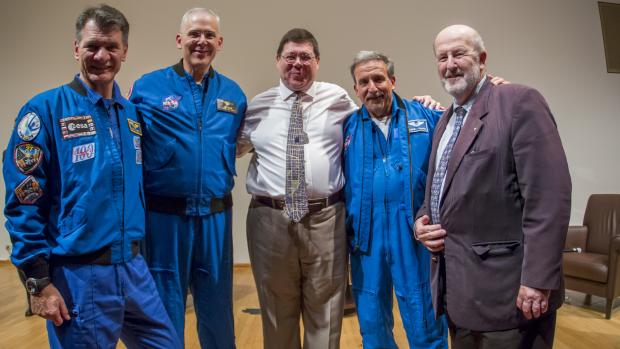Alumni Spotlight: John Zipay (’88)

John Zipay (center) at the Astronauts on the Square event.
If all you knew about John J. Zipay was his job, you might be tempted to think that his CV was the most noteworthy thing about him. After all, not many people can say that they’ve been affiliated for more than three decades with NASA, had a hand in the creation of the International Space Station (ISS), or helped shape the future of space flight with their work on the Space Shuttle and the Deep Space Gateway.
It’s all undeniably fascinating, but Zipay’s contributions to the engineering world extend well beyond his career accomplishments. He has, for example, been an enthusiastic supporter of NYU Tandon (known as Polytechnic University during his days here) and its students.
“I am still grateful for my education,” Zipay, who majored in aerospace engineering, says. “I had wonderful professors who taught a solid curriculum, and I still remember my courses in structures and thermodynamics very fondly.” He admits that he did not fully appreciate how rigorous Poly had been until getting out into the wider world. “I quickly discovered that not every engineer I met had received an education like the one I got in Brooklyn,” he recalls.
Among those meeting his admittedly high standards are the dozens of members of NASA’s Lyndon B. Johnson Space Center Structures Branch, whom he has supervised as Deputy Branch Chief for the last decade. Under his direction, they are creating innovative inflatable structures like the Bigelow Experimental Activities Module and providing technical support to Boeing and SpaceX in the development of their commercial crewed spacecraft. Zipay’s engineers are also responsible for Orion, a human spacecraft designed to enable future missions to deep space. (His previous titles included ISS Deputy Manager for Structures Integration, in which capacity he managed the engineering teams responsible for the design and testing of all ISS structures and mechanisms, integrated loads and microgravity analysis, and real-time on-orbit anomaly resolution.)
It’s been something of a dream job for Zipay, a Queens native who recalls staying up late to watch the Apollo 17 mission on television as a child. “When I was at Poly, they ran a cooperative education program with NASA, and I completed five, semester-long tours at the Johnson Space Center in Houston,” he explains, “and then I just never left.”
He sees a bright future for those who want to follow a trajectory similar to his own. “This is a generational process,” he says. “First we went to the Moon, then we entered the era of the ISS and the Shuttle Program, then came planetary probes and the Mars Rovers. The engineers now entering the field are going to build on all that knowledge and make commercial spaceflight and travel to the Moon and Mars a reality.”
He believes that all aspiring engineers should have the benefits of a first-class education. “Money should not be a barrier to earning a degree,” Zipay, a regular Tandon benefactor who was himself a recipient of a Board of Trustees scholarship, says. “It’s not good for industry, for the nation, or for society as a whole.”




